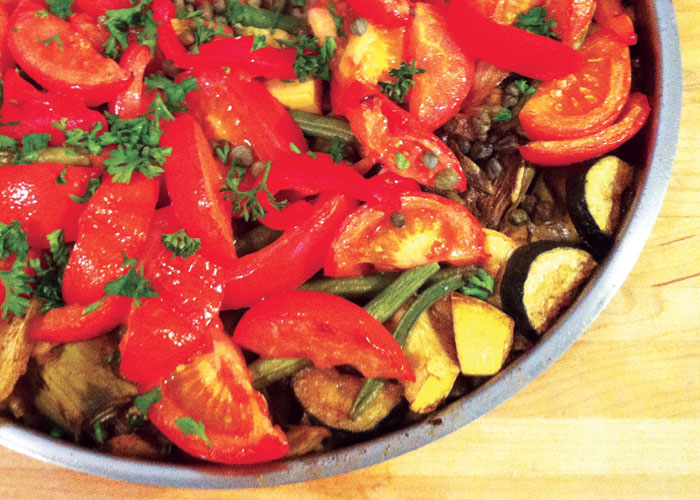Vegetable paella
|
Rice is the world’s most important staple food. It is grown in 115 countries and is the primary source of protein for millions of people. But rice production is tricky: The water footprint associated with rice production is one of the highest for crop production in the world. Water is needed to prepare a field (saturating the soil for one month prior to planting) and then maintain a standing layer of water of the paddy field that is later drained. Rice grown in monsoon-prone/wet areas, such as Vietnam and South Asia, contribute minimally to water scarcity. Rice from Egypt, India, Pakistan, Thailand or the USA have a potentially higher environmental cost. Interestingly, the Arborio rice I used in my paella was from Lundberg Family Farms, in the USA. They claim to “Eco-Farm” their rice, by practicing water-conserving irrigation, as well as other ecological programs. The USA Rice Federation is spending considerable funding to address the environmental impacts of rice production by developing computer programs that alert farmers when to drain their fields, leveling fields (which supposedly saves on water use) and investigating the feasibility of furrow– (as opposed to flood-) irrigated rice—Good research that will hopefully benefit other countries. So, why is rice so popular? Rice is inexpensive, easy to prepare, versatile, filling and a good source of protein, which is why it makes up 20% of the world’s dietary energy supply. Rice is very low in saturated fat, cholesterol and sodium. Brown rice trumps white rice in fiber content, vitamin B and E. Purple rice is thought to have antioxidant properties, and red and black varieties are thought to reduce the development of atherosclerotic plaques induced by cholesterol. However, contrary to popular understanding, the nutritional content of rice is poor; Rice does not provide necessary amino acids and other nutrients, and should be served alongside vitamin-rich vegetables. In rice-dependant societies such as Ethiopia and India, children do not survive common diseases because their immune systems are under-developed—They are not getting the necessary vitamins they need from their diet of just rice. This is why we see ‘enriched rice’ on grocery shelves, which is rice mixed with an assortment of vitamins and nutrients. This is better, but not great, because this enrichment can be ‘washed off’ when rinsed. The Golden Rice Project is researching how to better enrich rice with vitamin A. Vitamin A Deficiency is one of the most damaging and dangerous micronutrient deficiencies. In 2012 the World Health Organization reported that about 250 million preschool children are affected by VAD, and that providing those children with vitamin A could prevent about a third of all under-five deaths, up to 2.7 million children. To read more about this project, see here. This recipe serves about six to eight. Ingredients * I halved baby artichokes in my paella; they looked impressive, but they did not cook through. In future I would trim them down to just the hearts, or even use marinated hearts from a jar which may be easier/cheaper/more flavorful. Directions Recipe adapted from this one. Sources: Food and Agriculture Organization of the United Nations Jang, Sungjoon and Xu, Zhimin (2009). “Lipophilic and Hydrophilic Antioxidants and Their Antioxidant Activities in Purple Rice Bran”. Journal of Agricultural and Food Chemistry 57 (3): 858–862. T. Siebenmorgen, S. Linscombe, T. Walker, K. McKenzie, and D. Harrell. Research Efforts to Ensure Rice Industry Sustainability
|











